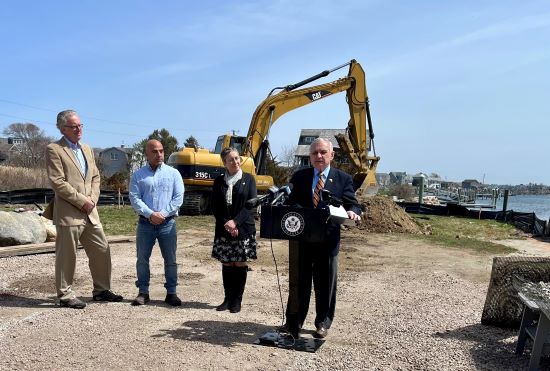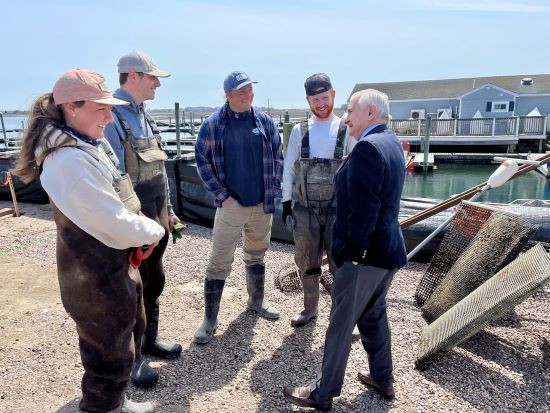GROUNDBREAKING: New State-of-the-Art Matunuck Shellfish Hatchery and Research Center will Cultivate Aquaculture Innovation & Economic Growth for RI


SOUTH KINGSTOWN, RI — Billions of tiny baby oysters will soon have a new high-tech nursery in Wakefield. Rhode Island shellfish farmers will soon have access to a healthier, more predictable supply of oyster spat to produce consistently high-quality oysters year-round. And University of Rhode Island researchers will soon have a new state-of-the-art research and innovation center to study bivalves, aquaculture, and more, along with a ‘test kitchen’ right across the street.

After years of planning and local input from residents, U.S. Senator Jack Reed today joined Perry Raso, a University of Rhode Island (URI) graduate who founded Matunuck Oyster Farm, Matunuck Oyster Bar, and Matunuck Vegetable Farm, and leading researchers from URI and members of the East Coast Shellfish Growers Association to officially break ground on the Matunuck Shellfish Hatchery and Research Center.
This new 4,118 square-foot facility, a partnership between URI and Matunuck Oyster Farm, will serve as a full-scale nursery/hatchery, growing and supplying oyster seed in Rhode Island and beyond. The hatchery will be a resource for the state’s shellfish farmers, serving as a hub for research and technology to help growers improve productivity and increase output.
In addition to oysters, the hatchery hopes to cultivate alternative aquaculture species, such as bay scallops, sea urchin, or possibly different types of seaweeds. And through new technologies and research, the Matunuck Shellfish Hatchery and Research Center will help ensure a safer consumer product, which will increase the per-unit value of Rhode Island-farmed shellfish crops.
When it is completed, the $2.4 million waterfront hatchery will have two main floors and a third-floor mezzanine area. The first two floors will have large high-tech spawning and culture tanks where the baby oysters are formed and filter-fed by water and algae that is grown in-house. When the oyster larvae grow big enough, they will be moved to setting tanks where they attach to shells to become spat. The spat may then be studied and assessed for size and strength before being sold to growers and taken to oyster farms throughout Rhode Island and beyond.
“Oyster farming can have a net positive impact on Rhode Island’s economy and environment. When it’s completed, this state-of-the-art oyster hatchery will boost bivalve research, increase production capacity, and ensure a reliable supply of oyster spat. It will use the latest in research and technology to help kick-start nature and allow local shellfish farmers to produce consistently high-quality oysters year-round. Ultimately, it will help boost sales of Rhode Island aquaculture. Aquaculture is good for the environment and our economy and it’s essential to the future of sustainable seafood, and the health of our local waters,” noted Senator Reed, a senior member of the Appropriations Committee, who secured $1.3 million to support the facility and provide the equipment these researchers need. Reed also delivered another $1 million earmark for URI in FY22 to support ongoing aquaculture and seafood research.
“On behalf of URI researchers, we are very excited about the research opportunities that this unique facility will provide, from developing lines of oysters resistant to disease and environmental stress for New England farmers, to figuring out ways to address production bottlenecks and testing and implementing novel methods to grow shellfish in a sustainable way,” said Marta Gomez-Chiarri, URI professor of Fisheries, Animal, and Veterinary Sciences.
“The Matunuck Shellfish Hatchery and Research Center will be a win for the state that puts us on the cutting edge of oyster research and helps ensure a sustainable, vibrant aquaculture industry. We are pooling resources here, with expertise and innovation from URI, federal investment, and local operations with the shared goal of producing world-class oysters that can be locally farmed and added to menus everywhere. We’ll be spawning oysters, shellfish, and perhaps seaweed as well, for our own farm as well as providing it to other shellfish farms. Oysters are essential to the health of our coastal ecosystems and they are good for the economy too,” said Perry Raso, owner of the Matunuck Oyster Farm and the Matunuck Oyster Bar, which has been named one of the top 15 seafood restaurants in America. “Senator Reed has been instrumental in helping this initiative come to fruition and I am grateful to him for being a longstanding champion of Rhode Island aquaculture and helping people like me grow our businesses.”
“We are excited for this groundbreaking. ECSGA has been pushing for this type of large-scale oyster genetic improvement project for over decade. This means really talented geneticists will be doing key work here, developing different lines of oysters and growing them out in various sites around New England with commercial growers who can do the work in coordination with these great scientists. And they’ll bring specimens back to the lab with optimal traits, such as shell shape, growth rate, etc. so they can be spawned the next year. The result will be oysters that are locally adapted, resistant to disease, and perform well,” said Bob Rheault, Executive Director of the East Coast Shellfish Growers Association. “Thank you to Senator Reed for his continued support of our industry and helping it grow. Oysters from Rhode Island are putting smiles on people’s faces all across the country so they promote tourism in the Ocean State as well.”
The contractor in charge of building the new facility is DiStefano Brothers Construction, Inc. The construction phase is expected to be completed in winter 2023. The new building will then be equipped with the latest technology for researchers and scientists, including specialized tank systems, water treatment and monitoring systems, and high-performance computing and smart environmental monitoring equipment.
Once it is up and running, shellfish seed will be available to oyster farmers locally, and regionally. The Matunuck Shellfish Hatchery and Research Center will also grow shellfish larvae for restoration projects, as well as work with the University of Rhode Island to develop alternate species, such as bay scallops, sea urchins and seaweed, all of which would benefit shellfish aquaculturists in the region.
There are currently 84 oyster farms in Rhode Island, and hundreds more in the region, that could potentially purchase seed and take part in restoration projects.
In 2002, the total dollar value of aquaculture in Rhode Island was about $300,000. That year, Senator Reed secured nearly $2 million in federal funding to hatch the Rhode Island Aquaculture Initiative, which has increased the breadth and depth of the Ocean State’s aquaculture industry.
By 2021, Rhode Island’s aquaculture industry had grown to producing $7 million annually, according to the Rhode Island Coastal Resources Management Council (CRMC).